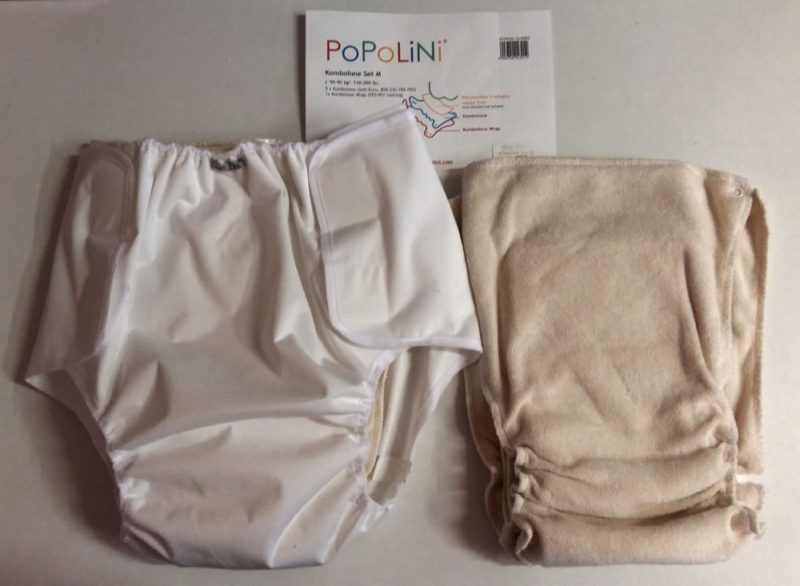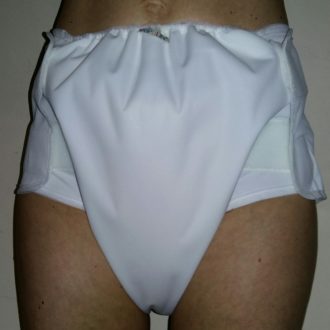Washable nappies, organic clothing for children, baby carriers and slings
Washable nappies, organic clothing for children, baby carriers and slings

Adults and seniors with incontinence who suffer from irritation caused by the use of disposable diapers can benefit from washable adult diapers.
Popolini’s washable cotton diaper is inspired by the models of washable baby cloth nappies that the company is producing for almost 30 years. The main features are skin softness, breathability, high absorbency and comfort, as shown in the following video:
Popolini’s reusable diaper, Kombolone model, consists of 2 elements.
The cover is in a technical material that is waterproof but breathable at the same time. It is elasticated at the waist and closes with velcro. It is designed to be used in combination with the absorbent cotton insert; however it can also be worn as a cover under traditional disposable diaper to contain any leaks.
The cotton insert attaches to the waterproof cover with snap buttons: once the buttons are attached, the complete diaper is ready to be used and worn. The insert is composed of a thick layer of absorbent organic cotton: the inner part (not in contact with the skin) is made of polyester and viscose, absorbent materials that dry quickly.
All Popolini products, such as this adult washable nappies, are equipped with the Oeko Tex Standard 100 Class I certification, which guarantees the suitability of the product for contact with the skin of babies and children. Consequently, the materials of these washable nappies are also suitable for all sensitive and irritated skin, such as the skin of the elderly and wearers of incontinence diapers.

Washable adult diaper worn
The waterproof cover and cotton inserts can be purchased separately in the desired number. Alternatively, you can buy the savings set which includes a waterproof cover and 5 cotton inserts, stored in a practical cotton bag. Alternatively or in addition to the inserts described, it is also possible to purchase rectangular absorbent cotton inserts, to be used – folded in three parts – inside the panty: they are called “prefold”.
If you prefer a more dry sensation, you can place thin, washable draining liners on the cotton diaper, made in a technical fabric called “Stay-Dry”: it is an Oeko-Tex certified fabric that lets the wet through keeping the skin drier.
In the presence of feces you can use biodegradable liners instead: they are viscose veils that can be thrown into the toilet together with the feces and that make it easier to change the diaper. They also prevent the diaper from getting excessively dirty. These liners can be washed several times in the washing machine together with the diapers if they are simply wet with pee.
Look into the e-shop all the useful products for adults with incontinence problems in the washable diapers for adult category.
The new cotton inserts should be washed once or twice to make them absorbent: in fact, they reach their maximum absorbency a little at a time after a few uses. They can be washed in the washing machine with the rest of the laundry at 40°- 60 °C. A domestic wash at 60°C is already sufficient to eliminate most of the bacterial load. After use, the wet diaper is put in a bin with a lid until washing or directly in the washing machine; if it is dirty with feces it is best to rinse it while waiting for washing.
If possible, it is best to use an ecological detergent, without optical whiteners or bleach, to avoid skin irritation; it is advisable to carry out a pre-wash or a double final rinse to eliminate any traces of detergent and / or urine. Rinses with fabric softener are not recommended because they make the diaper less absorbent: you can replace the softener with citric acid diluted to 10-15% in the softener compartment. In fact, citric acid prevents limescale from settling on the tissues making them more rigid.
For more information or to order you can write a message directly here, or call +39 342 7616744.
Lucia
ARTICOLI CORRELATI
01/06/2022 Washable Nappies
Adult incontinence swimwear for swimmingpool and for the sea
04/06/2018 Washable Nappies
31/05/2018 Washable Nappies
Children’s swim nappies for the pool and sea: how do they work?
24/06/2016 Mothers and children
Scrivi il tuo commento
By using the site, you accept our use of cookies. more information
This site uses cookies to provide the best browsing experience possible. By continuing to use this site without changing your cookie settings or by clicking on "Accept" you allow their use.